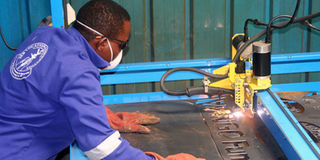Jobs in manufacturing declining, says report

Jobs in manufacturing have been declining since 2013. Photo | File
What you need to know:
- While in the 2012/13 financial year manufacturing absorbed 7.3 per cent of all workers, the figure declined to 4.2 per cent in the 2016/17 financial year.
A report by the Economic Policy Research Centre (EPRC) has revealed that employment from the manufacturing sector and its contribution to the country’s gross domestic product has steadily declined over the years partly due to automation.
According to the research, while in the 2012/13 financial year manufacturing absorbed 7.3 per cent of all workers, the figure declined to 4.2 per cent in 2016/17 corresponding to the loss of about 200,000 jobs.
“For manufacturing, the employment elasticity is negative and sizeable, which could suggest that automation in the sector replaced workers,” the report reads in part, adding that slump indicates limited potential for the sector to function as an engine for structural transformation and job creation.
Uganda has for many years prioritized industrialisation as the theme in national budget with expectations of creating jobs for the public.
Mr Martin Wandera, the Ministry Gender director of labour, employment, occupational safety and health, said while there is a huge potential for manufacturing in Uganda, inhibitors such as infrastructure, affordable and long term credit, research and development need to be addressed.
“That linkage between research institutions [such as] Uganda Industrial Research Institute [must put focus] on local private sector so that firms can be incubated and supported to go into business,” he noted.
Dr Madina Guloba, an EPRC senior research fellow, said manufacturing, which is only at infancy level, is also affected by binding agreements related to meeting quality standards and supply chains, which, coupled with liberalisation of the economy amid globalization, hinder growth of the sector.
Thus, she said, government must incentivise local manufacturers to protect parts of the manufacturing sector for local growth.
IWOSS Sectors
The report recommended looking to Industries Without Smokestacks (IWOSS) such as agro-food processing, horticulture and tourism transport and financial & business services for job creation.
“In 2016/17 IWOSS sectors provided employment for 22.6 per cent of Uganda’s employed workers, an increase from 2013 by 1.3 percentage points. Non-IWOSS sectors [such as] agriculture [and] informal trade accounted for most jobs (together these two sectors absorb 54.7 per cent of all workers in 2016/17),” the report highlights.
“Industries without smokestacks, which have characteristics similar to manufacturing are labour intensive and have a high labour productivity,” Mr Medard Kakuru, a research analyst at EPRC said, noting IWOSS sectors have a huge potential for job creation.
According to Dr Guloba, there is potential of 300,000 jobs for youth from the IWOSS sector in the next decade.




